Bronze deer sculptures are a near-standard feature of many of the world’s top hunting clubs, private estates, and historic hunting lodges. More than just decoration, they serve as a statement, deeply ingrained in the core of hunting culture.
Top 10 Bronze Deer Sculptures for Hunting Grounds
Top 1 Large Roaring Stag Sculpture
Dimensions: H: 86.6 (in)
Item No: BAN-055
The stag sculpture depicts the iconic moment of a roaring deer. Its head is held high, its mouth open, as if it is releasing a resounding, long roar (a behavior known as “bugling” in North American elk).
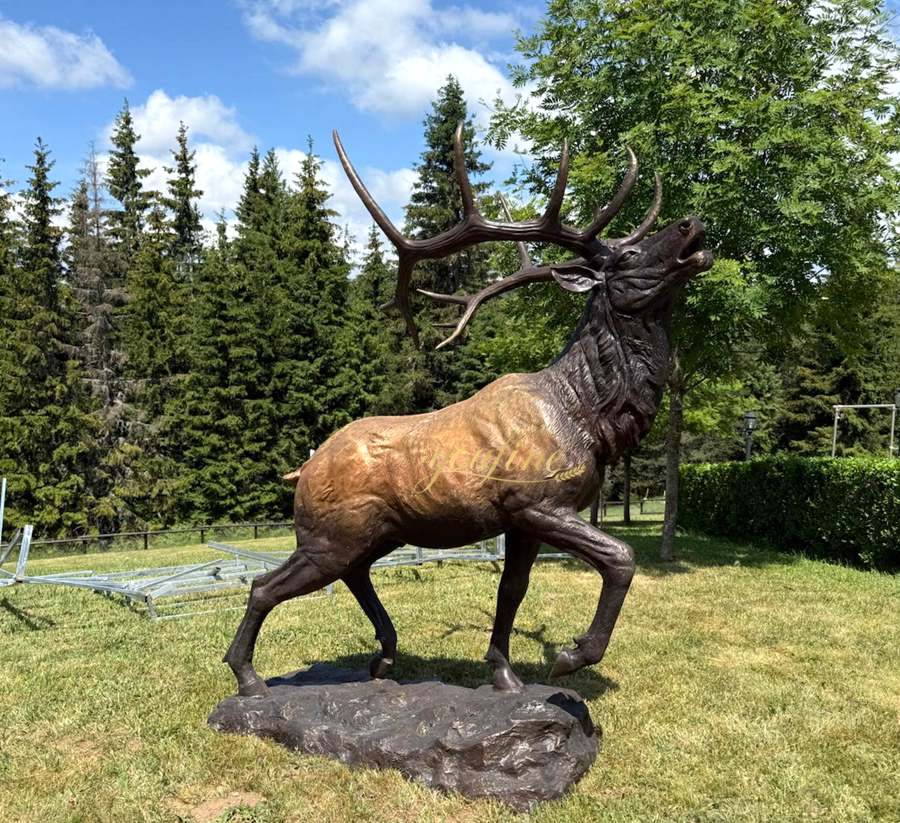
The sculpture’s posture is dynamic, with one front hoof gracefully raised and its body slightly twisted, as if it is about to take a step forward, or perhaps has just paused, attracted by a sound. The sculpture seamlessly blends into the surrounding natural hunting landscape (meadows and woods). It doesn’t resemble an isolated piece of art, but rather a real deer living on the edge of the woods, calling out loudly to compete for territory or attract a mate.
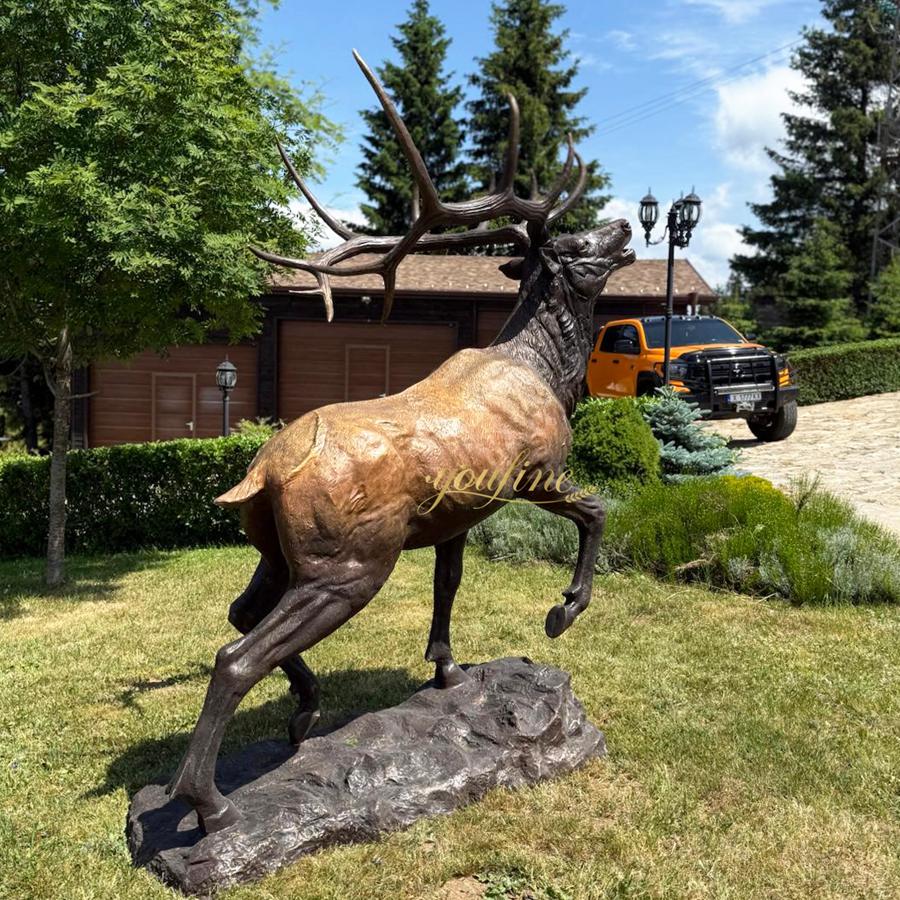
Top 2 Two Fighting Elk Sculptures
Dimensions: H: 43.3 (in) L: 169.2 (in)
Item No: BOKK-267
This pair of deer sculptures is strategically placed on a gently sloping surface made of rocks and wood chips. The sculptures depict two adult male elk (Wapiti) in a fierce struggle. The sculptures are situated in a dense forest of aspen and birch trees, a typical habitat for North American elk.
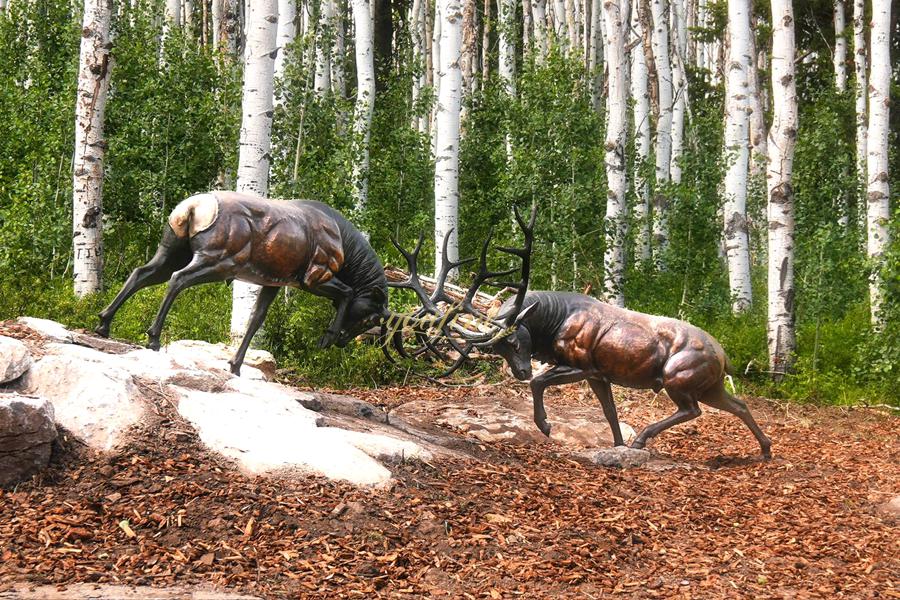
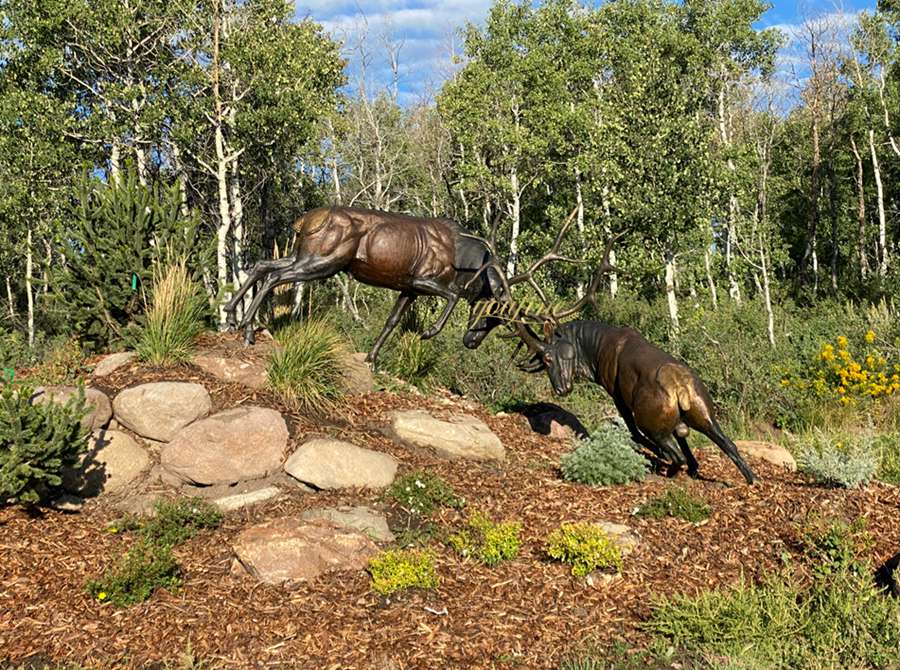
Top 3 Roaring Deer Standing On a Rock
Dimensions: H: 70.8 (in)
Item No: BOKK-269
This bronze sculpture depicts a majestic, mature stag, its posture and details imbued with power and majesty. The sculpture captures the iconic moment of the stag roaring to the heavens.
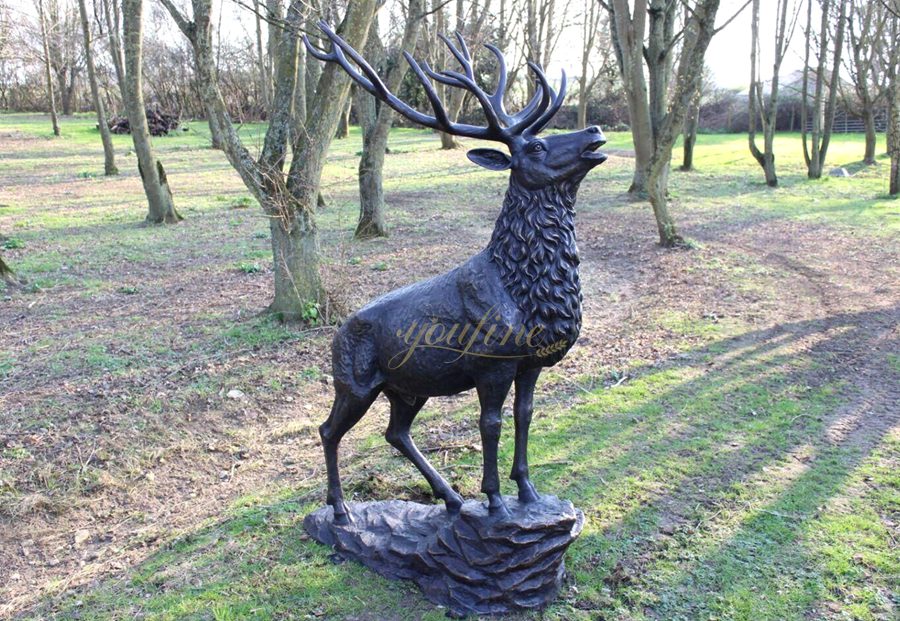
Our bronze stag, as if a true master of the forest, evokes a raw, solitary, and untamed beauty. It is not hunted, but rather masters its own world, imbued with natural majesty.
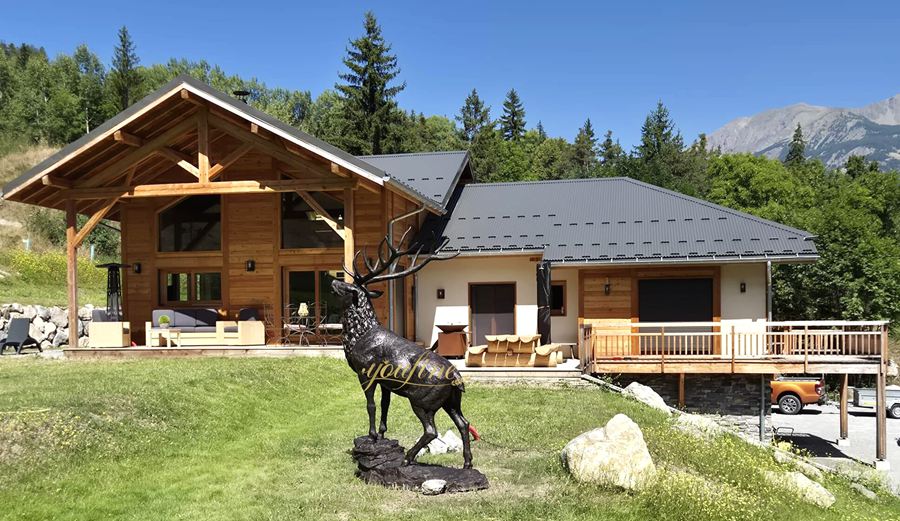
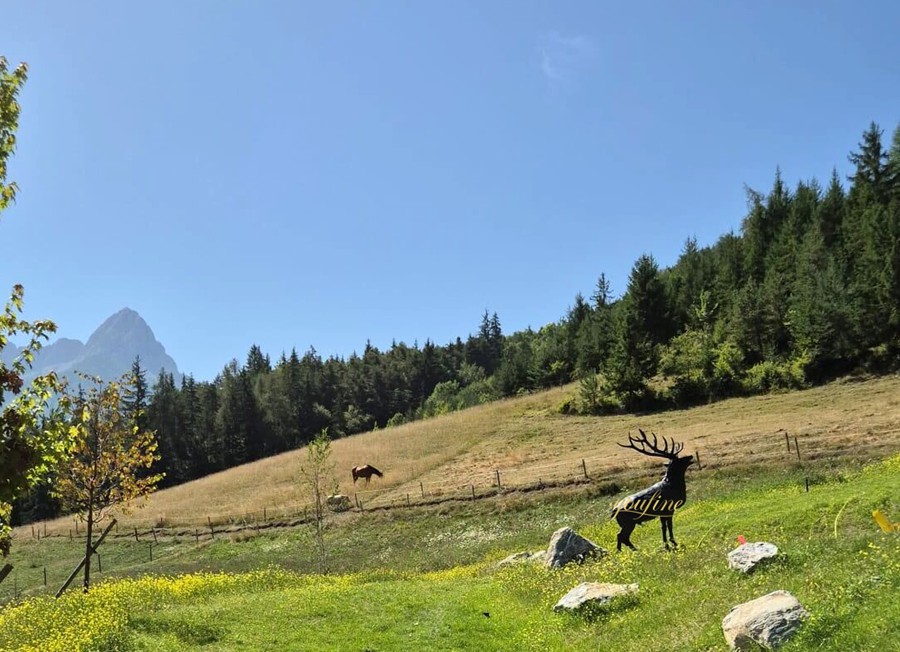
Top 4 Sculpture of a Leaping White-Tailed Deer
Dimensions: H: 70.8 (in)
Our bronze deer sculpture captures a large buck galloping across a rugged landscape, imbued with power and movement. The deer is placed upon a mass of rocks, boulders, and weathered wood piles, creating an atmosphere of grandeur, majesty, and primal power.
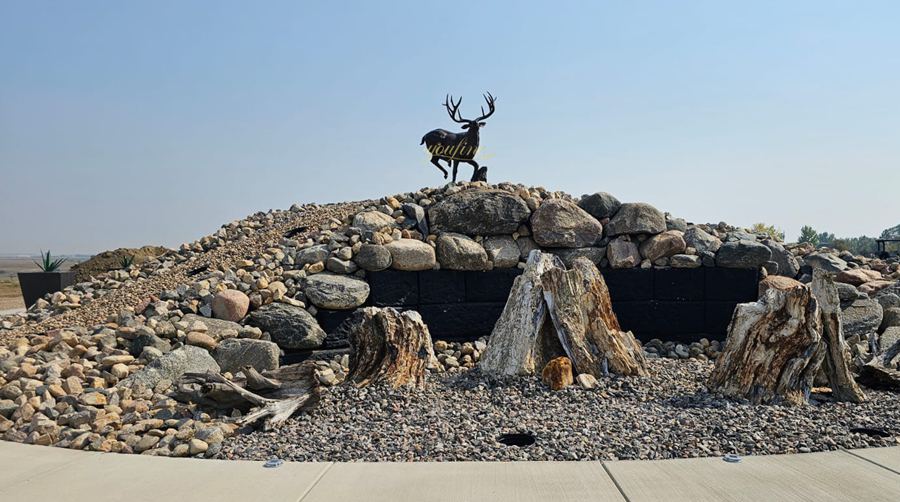
Top 5 Standing White-Tailed Deer Sculpture
Dimensions: H: 50 (in)
The bronze sculpture of Doe captures the deer standing still, looking back intently, showcasing a tranquil, graceful, and alert beauty. Together with the old barn, meadow, and birch trees in the background, it forms a tranquil and beautiful pastoral painting.
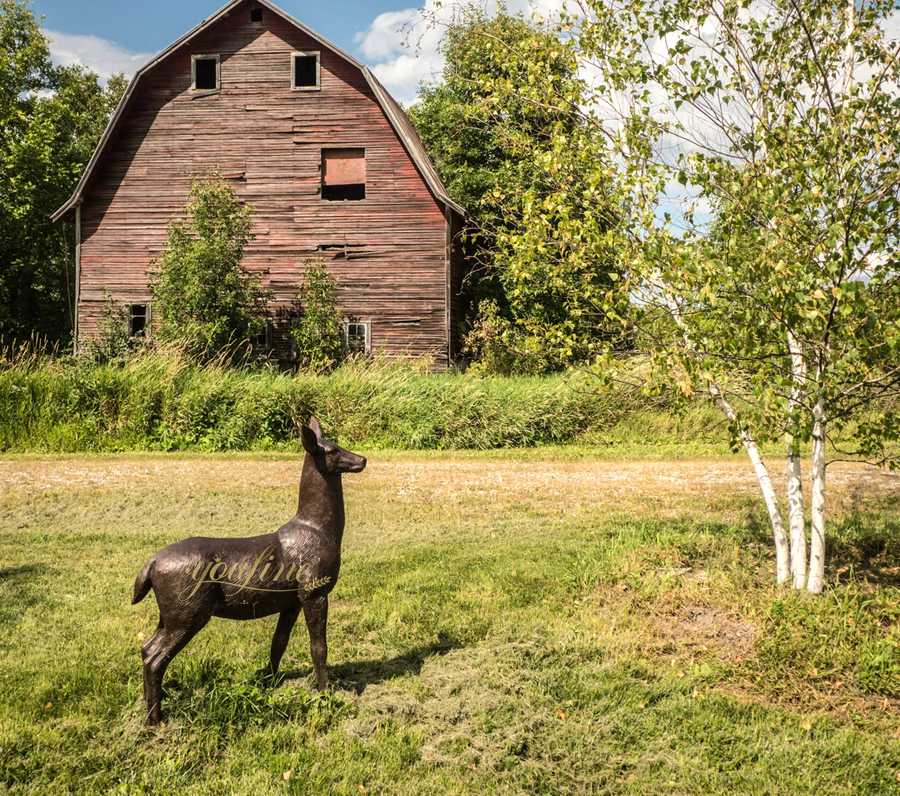
Top 6 Three Elk Sculptures Standing On The Rocks
Dimensions: H: 27.5 (in)
Item No: BOKK-275
The three elk, each in a different pose, are all alert and dynamic, as if frozen in time. Our client placed them on a rock pile that simulates a natural plateau, successfully integrating the bronze deer sculptures into the natural environment.
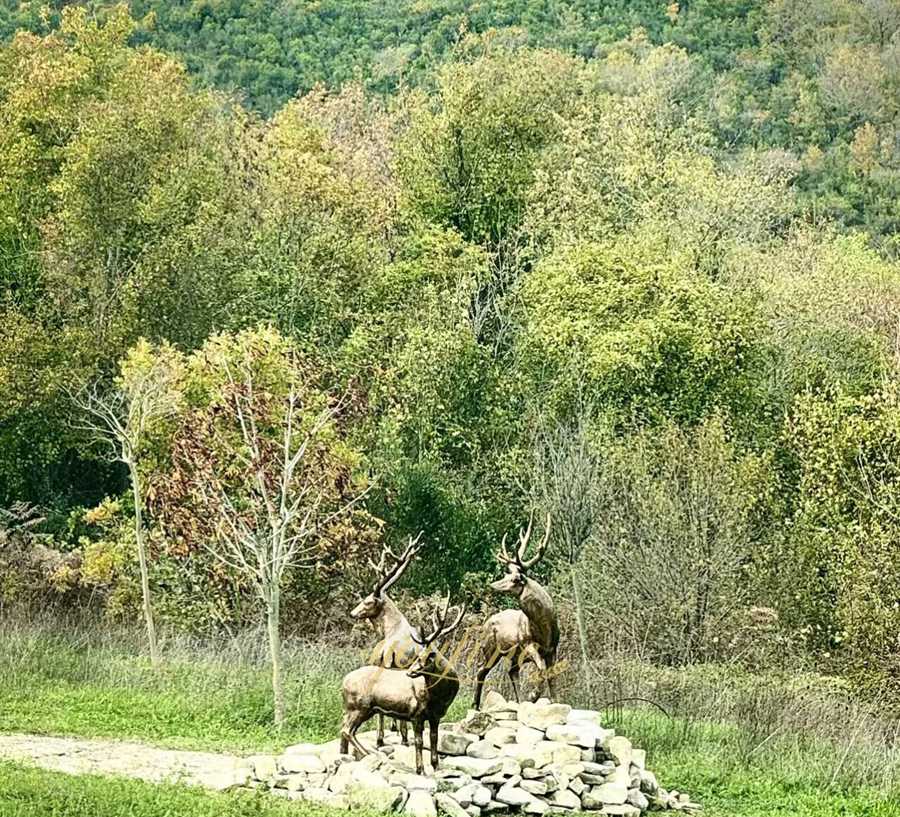
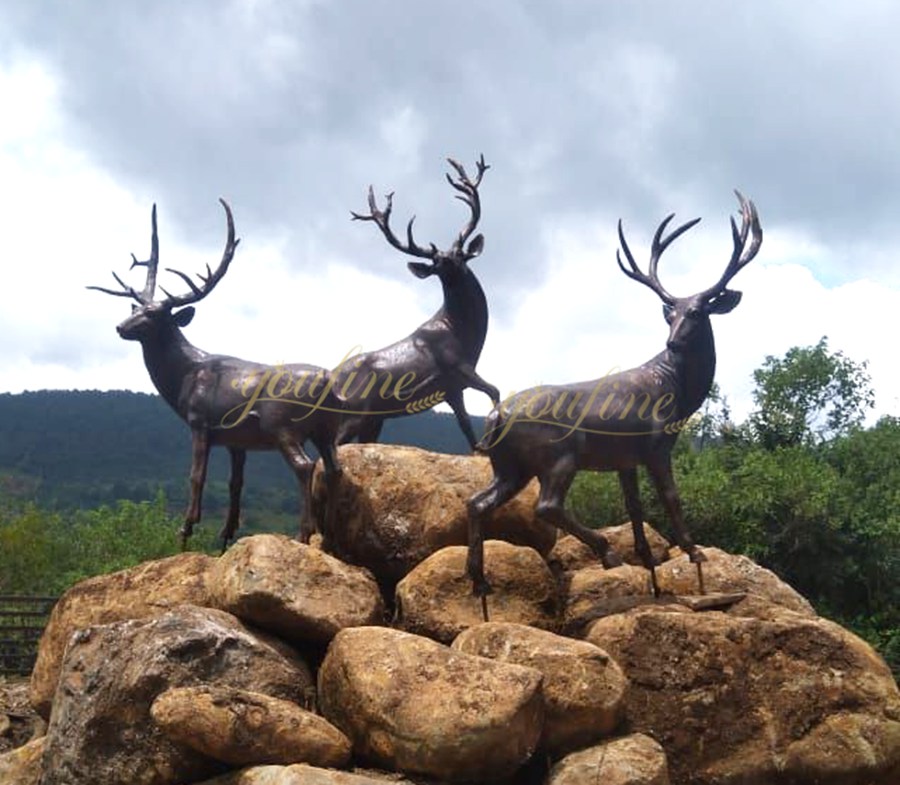
Top 7 Bronze Roaring Deer Sculpture
Dimensions: H: 96.4 (in)
This dynamic sculpture of a roaring stag is cleverly placed within a vast winter snowscape. The bronze deer’s head is tilted back, its mouth wide open. This iconic pose perfectly captures the resounding “bugle” (roar) stags make during the breeding season, often used to declare territory, challenge competitors, or attract females.
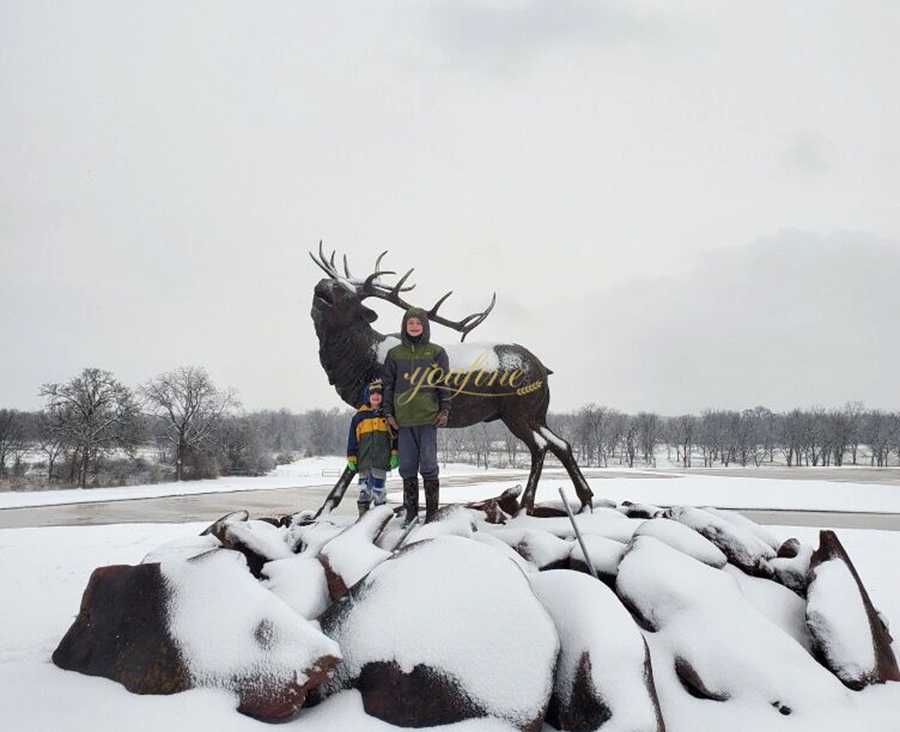
This bronze deer sculpture, roaring to the sky, with its antlers stretched and powerful, is placed in an open and tranquil lakeside estate environment. It is a singing stag, full of primitive strength and vitality.
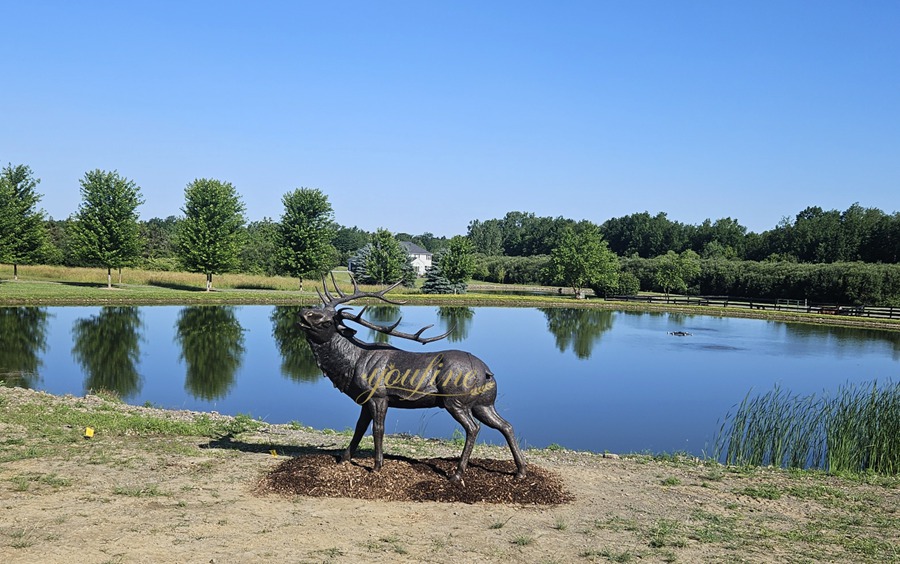
Top 8 Deer Sculpture Standing In a Daze
Dimensions: H: 71.6 (in)
The stag stands on all fours, its body relaxed and stable. Its expression is remarkably serene and composed, with even a touch of daze or contemplation, as if quietly observing its surroundings. The interaction between the bronze deer and the client’s dog successfully creates a warm and harmonious pastoral atmosphere.
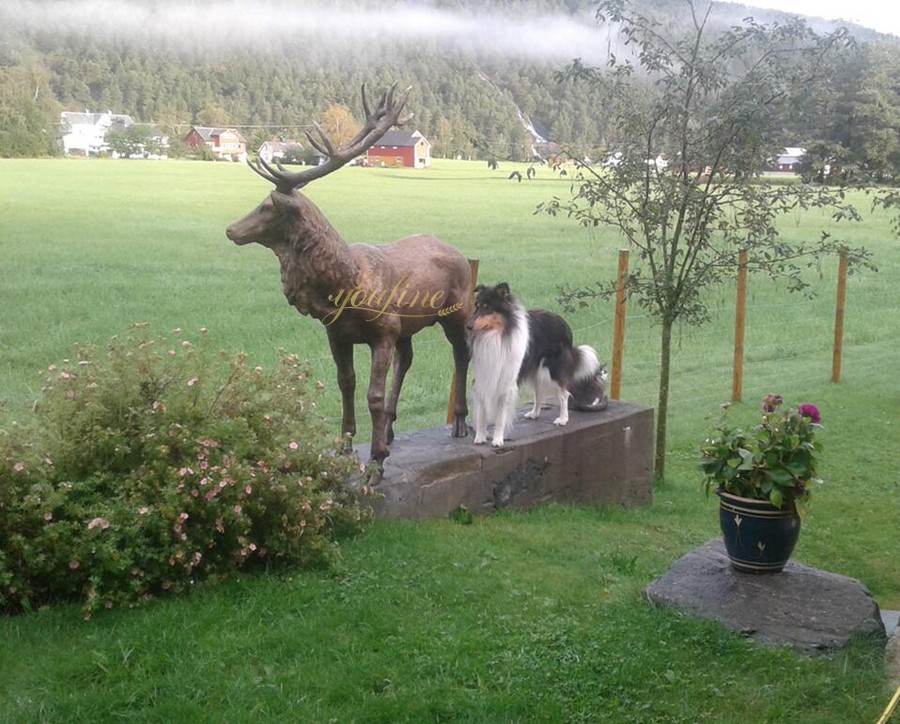
Top 9 Deer Looking Back With Its Legs Raised
Dimensions: H: 90.5 (in)
This sculpture depicts a stag in alert, capturing the moment it is suddenly startled and hunted while moving through the forest. Our sculpture’s massive, backward-stretching, multi-branched antlers create a powerful and beautiful form, symbolizing the stag’s power and status, and adding a majestic aura to the sculpture.
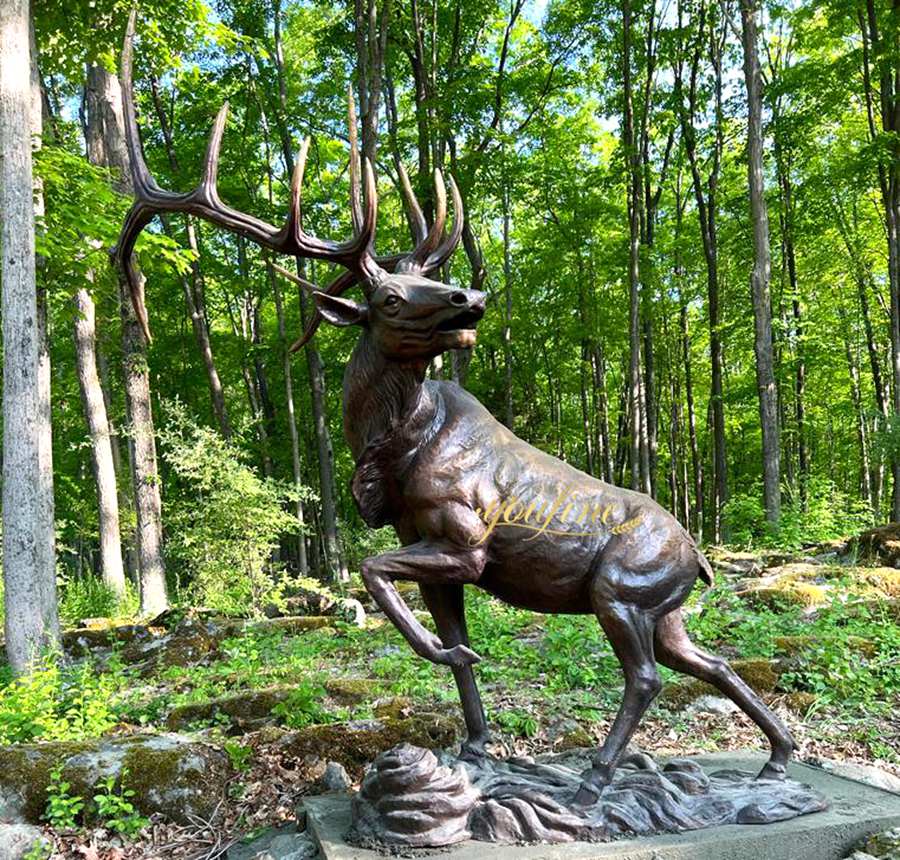
Top 10 Large Bronze Moose Statues
Dimensions: H: 63.3 (in)
Item No: BOKK-282
This pair of bronze moose sculptures, with their majestic palm-shaped antlers, unique body structure, and modern black color, exudes power and solemnity. The black color imbues the sculptures with an extra sense of solemnity, mystery, and power, making them ideal for placement in the center of a hunting ground.
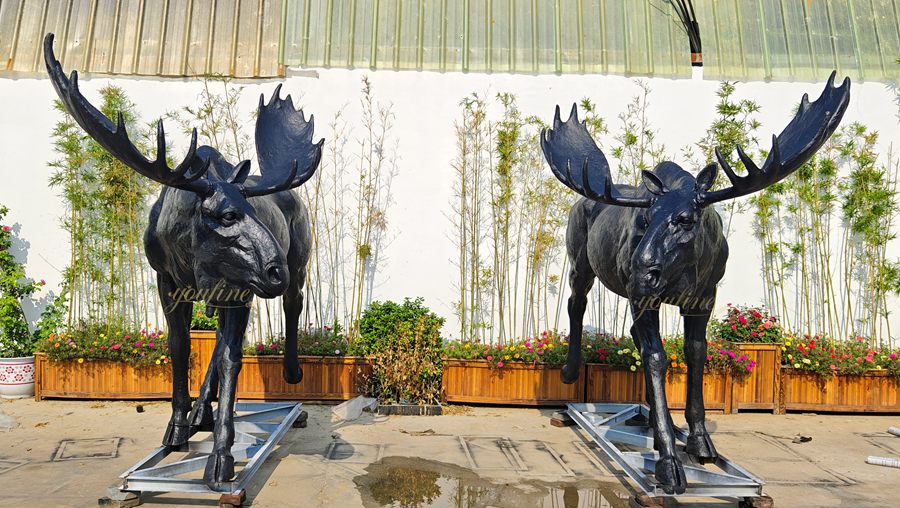
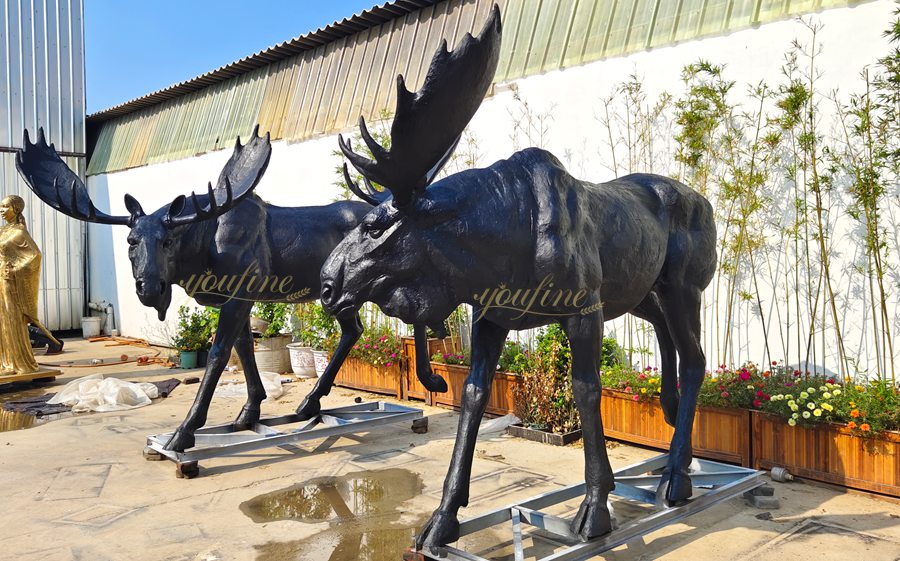
Why are Bronze Deer Sculptures Placed in Hunting Grounds?
1. As a Timeless Hunting Monument
For hunters, one of the highest honors in hunting is successfully capturing a stag with magnificent antlers and a sturdy physique. However, taxidermy, while authentic, decays over time. A bronze deer sculpture, on the other hand, perpetuates this honor and memory through artistic and idealized forms. It captures not the moment of death but the vitality, majesty, and spirit of the animal at its peak. It stands as a timeless monument to hunting.
2. A Symbol of Aristocracy and Legacy
In the West, hunting has long been a traditional activity for kings, nobles, and the upper class, symbolizing power, courage, and control over the land. Hunting lodges are more than just resting places; they are also sanctuaries for socializing, displaying trophies, and passing on family history. Within such spaces, a solemn and elegant bronze deer sculpture perfectly embodies this aristocratic ambiance. It represents a lifestyle and family honor passed down from generation to generation, transcending a single hunt.
3. Idealized Respect for Nature
Many true sportsmen harbor a deep reverence for nature and the prey they pursue. Through the artist’s creative process, bronze sculptures can refine and elevate the image of the deer, embodying an idealized, almost sacred beauty. This expresses a complex philosophy: hunters pay tribute to the might of nature by pursuing and capturing the strongest life. The sculpture thus becomes a symbol of the primal, intense, and awe-inspiring relationship between man and nature.
4. Durability and Aesthetic Focus
Hunting lodges are often built within natural environments, requiring artwork that can withstand the rigors of various climates. Bronze’s durability makes it an ideal choice for outdoor and semi-outdoor spaces. Furthermore, a visually striking deer sculpture can instantly become a focal point in an entire estate or hall, highlighting the owner’s taste and wealth.
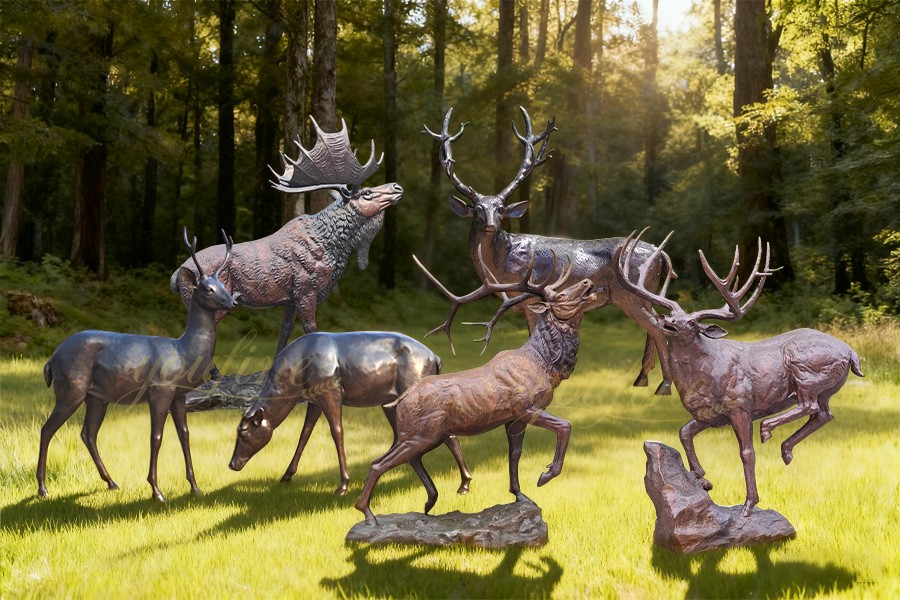
Famous Hunting Grounds
Hunting-Related Venues Featuring Bronze Deer Sculptures
While many premier hunting venues are private and their artworks hidden from public view, we can find examples from some renowned public estates and landmarks with a history of hunting:
Biltmore Estate, USA
This is the largest private estate in the United States, built by the Vanderbilt family during the Gilded Age. The estate boasts vast woodlands, and hunting was a key pastime. The estate’s art collection and architectural décor are rich with references to nature and hunting. The renowned Statue of Diana in the gardens, depicting Diana as the goddess of the hunt, often accompanied by deer, exemplifies the fusion of hunting culture and classical art. Animal sculptures scattered throughout the estate create an aristocratic, pastoral atmosphere. Scottish Highland Estates:
Scotland, home to the red deer, is a world-renowned hunting destination. Many historic Scottish castles and estates, such as those near Balmoral Castle, consider the deer a core cultural symbol. Bronze sculptures of stags standing tall are often seen at the entrances or in front of the main buildings of these estates, symbolizing both Scotland’s wild nature and its aristocratic traditions.
Hunting Lodges in the Black Forest, Germany
This region has a rich hunting tradition. Many upscale hotels and private clubs, converted from historic hunting lodges, are decorated with antlers, paintings, and bronze deer sculptures, creating a rich, traditional atmosphere.
Popular and Famous Bronze Deer Sculpture Subjects
Some bronze deer sculptures have become beloved classics across cultures:
The Stag of Saint Hubertus
This is one of the most legendary deer images. Legend has it that on Good Friday, the hunter Hubert was chasing a stag. As he was about to release his arrow, the stag turned, revealing a luminous cross between its antlers. This divine revelation led to his conversion. This image represents divine revelation and a reverence for life. The iconic image, popularized by the trademark of the famous German liqueur Jägermeister, has made it widely known. Sculptures based on this theme are popular with collectors with religious beliefs or a love of the mystical.
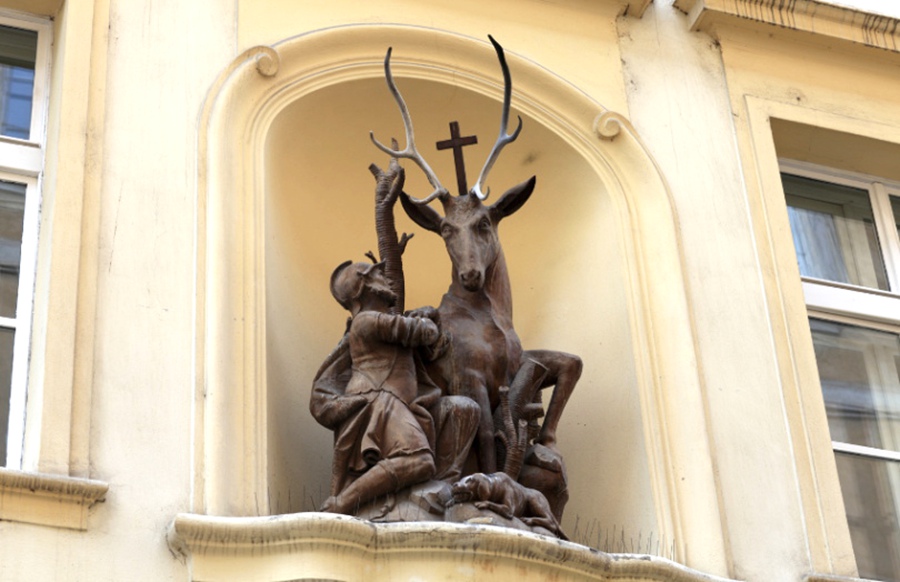
Diana of Versailles
This world-renowned Roman marble sculpture (later coined in numerous bronze copies) is now housed in the Louver Museum in Paris. It depicts Diana (Artemis), the goddess of the hunt, with a fawn. This work defines the elegance and sacred beauty of the deer in classical art and is a classic in Western art history. Bronze copies of the sculpture can be found in major museums and classical gardens.
Dynamic Realism Sculptures:
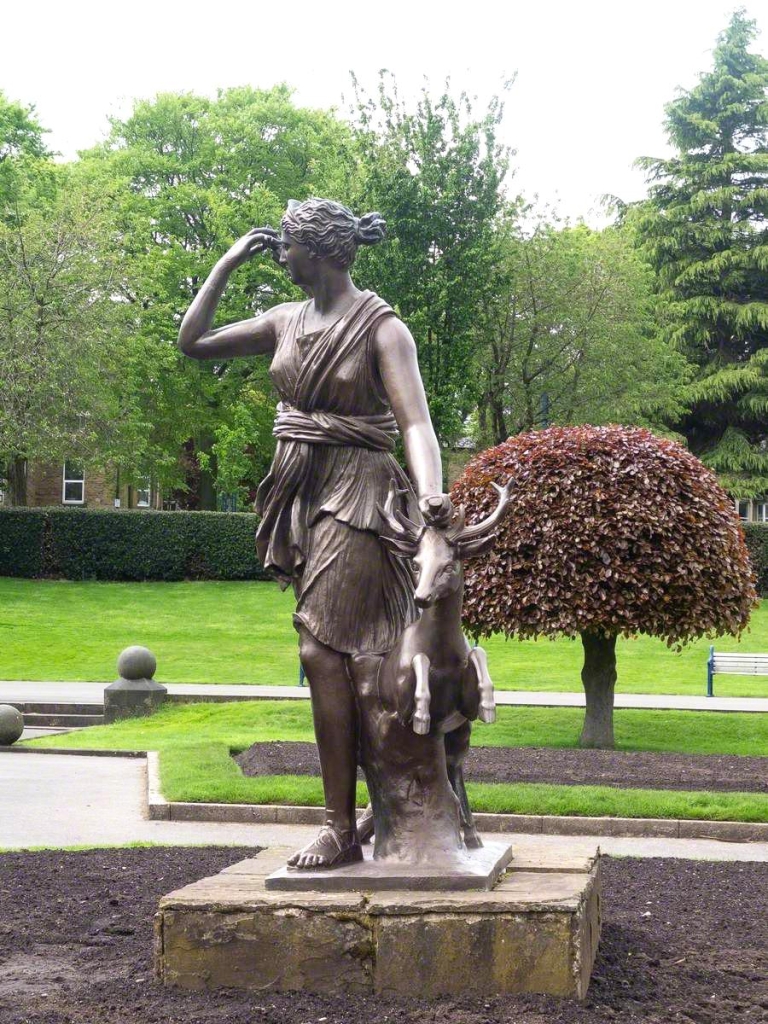
Contemporarily, bronze deer sculptures created by wildlife artists are also extremely popular. These works, free from mythological or classical representations, focus on capturing the dynamic moments of deer in nature: the fierce battle between two males, the nimble movements of a herd leaping across a stream, or the moment of alert gaze back in the forest. These works, imbued with vitality and drama, are beloved by wildlife enthusiasts and hunters.
In hunting culture, bronze deer sculptures are the embodiment of glory, the carrier of tradition, and the sublimation of art. They transform a fleeting chase into a tangible, enduring story.
Judy Guo, a 20-year veteran of bronze casting, is the co-founder and lead artisan of YouFine Art Bronze Foundry. Deeply rooted in the foundry, she has mastered every detail of the craft. Her expertise guarantees that each sculpture embodies the highest standards of quality and artistic integrity.